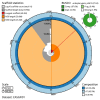The genome sequence of the Judas Tree Seed Beetle, Bruchidius siliquastri Delobel, 2007
- PMID: 39132672
- PMCID: PMC11316170
- DOI: 10.12688/wellcomeopenres.21109.1
The genome sequence of the Judas Tree Seed Beetle, Bruchidius siliquastri Delobel, 2007
Abstract
We present a genome assembly from an individual male Bruchidius siliquastri (the Judas tree Seed Beetle; Arthropoda; Insecta; Coleoptera; Chrysomelidae). The genome sequence is 375.6 megabases in span. Most of the assembly is scaffolded into 11 chromosomal pseudomolecules, including the X and Y sex chromosomes. The mitochondrial genome has also been assembled and is 15.81 kilobases in length. Gene annotation of this assembly on Ensembl identified 17,940 protein coding genes.
Keywords: Bruchidius siliquastri; Coleoptera; chromosomal; genome sequence; the Judas tree Seed Beetle.
Copyright: © 2024 Barclay MVL et al.
Conflict of interest statement
No competing interests were disclosed.
Figures





References
-
- Barclay MVL: Bruchidius siliquastri Delobel, 2007 (Chrysomelidae, Bruchinae) new to Britain. The Coleopterist. 2014;23(2):41–44. Reference Source
-
- Bates A, Clayton-Lucey I, Howard C: Sanger Tree of Life HMW DNA Fragmentation: Diagenode Megaruptor ®3 for LI PacBio. protocols.io. 2023. 10.17504/protocols.io.81wgbxzq3lpk/v1 - DOI
LinkOut - more resources
Full Text Sources

